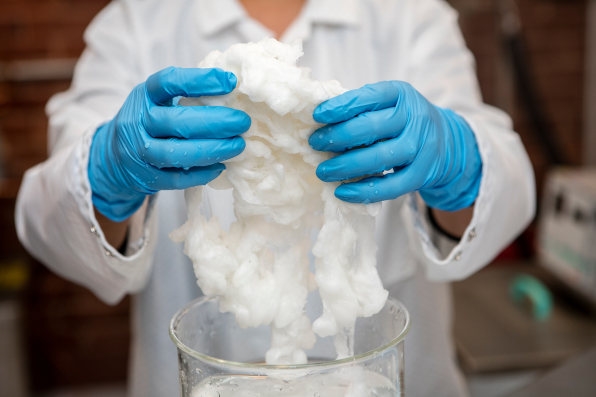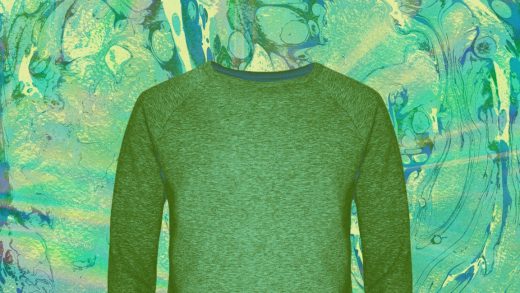This silkworm-based coating is a replacement for the toxic chemicals on our clothes
In the 1970s, U.S. Congress required flame retardants to be added to children’s pajamas to protect them in case of fire. These were the days before smoke detectors were required in bedrooms (now required per a 1993 National Fire Protection Association code), but when the chemical that was used, Tris(2,3-dibromopropyl) phosphate, was found to be a mutagen, a gene-altering agent, consumers called for action, and the federal Consumer Product Safety Commission soon prohibited it.
But that was just a single toxic chemical: The modern textile industry continues to rely extensively on the use of undisclosed chemicals to improve the performance features of fabric and apparel. In December 2018, a study from the environmental research center The Ecology Center found that 83% of children’s car seats tested contained toxic chemicals used as flame retardants. Even the National Institute of Environmental Health Sciences recognizes that many of flame-retardant chemicals “are associated with adverse health effects in animals and humans,” such as endocrine and thyroid disruption or impacts to the immune system.
According to a white paper of research gathered by chemistry company Evolved By Nature, more than 150 chemicals are now regularly used to enhance fabric characteristics, offering everything from a softer feel to faster moisture wicking, wrinkle resistance, improved water repellency, and better color vibrancy. As consumers’ demands for cheaper yet high-performing textiles grow, companies and mills respond by coating fabrics in chemicals that meet standards as a quick fix.

[Photo: Evolved By Nature]
But while some of these chemicals are also demonstrated carcinogens, or capable of reproductive, nervous, and endocrine system dysregulation, others are allergenic or irritating. Even when we wash the fabric and the chemicals are eventually removed, they linger on our non-laundered fabrics (like our sofa or curtains) or get into our water systems after washing. Many of them do not easily degrade, and the compounds build up in the environment and affect animal life.
So while going plastic-free or switching to recycled plastics in textiles is an important mission for the clothing industry (and one that’s been the central focus for clothing companies like Everlane or Girlfriend Collective), it won’t fix the chemical problem. Greg Altman, Evolved By Nature’s CEO and cofounder, and his cofounder, Rebecca Lacouture, are concerned about how our body is absorbing the chemicals we wear and touch, and how that affects public health at large.
The solution the company developed is what they call “Activated Silk,” a natural alternative to the current petrochemical finishes that can be used for a variety of performance-enhancing needs, like moisture wicking and color retention. It’s made from silkworm cocoons discarded by the textile industry, water, and salt.
Evolved By Nature has raised $51 million to date, from investors including The Kraft Group, Roy P. Disney, and Jeffery Vinik. The company says Activated Silk is cost-competitive with existing chemicals, and it’s straightforward to adopt since it requires no disruption to a company’s existing manufacturing processes or equipment. Activated Silk is currently available as an ingredient in two skincare brands, Silk Therapeutics and LabGrab, and Evolved By Nature says it’s currently working with a range of undisclosed fashion and personal care brands to make its technology more available in the latter half of 2019.
The Evolved By Nature white paper notes that we have little understanding of the effects of long-term exposure, because typical toxicological testing protocols generally assess higher doses for shorter periods. Because the typical exposure from one item is so low-dose, regulatory agencies might not see testing as a priority, and therefore health risks have not been adequately studied. So while chemical doses from one garment may be minuscule, we also need to consider the cumulative exposure from our bedsheets, car seats, upholstery, accessories, and towels.
“The health risk is that we as a human body, as a human vessel, are starting to accumulate foreign chemistry that is causing human biology to now co-evolve in ways that we’ve never asked human biology to do before,” Altman says.
He doesn’t think wearing yoga pants every day will give you cancer in 20 years, but he and his company operate under the assumption that it’s smarter not to take a risk. Instead, he notes that we’ll see effects at large with our population, like early puberty in boys and girls, or hormone and fertility changes from endocrine disruption. “If you know you are being exposed to foreign chemistry and it is entering the human body, we should avoid that exposure. That is the safest route,” he says.
(10)



